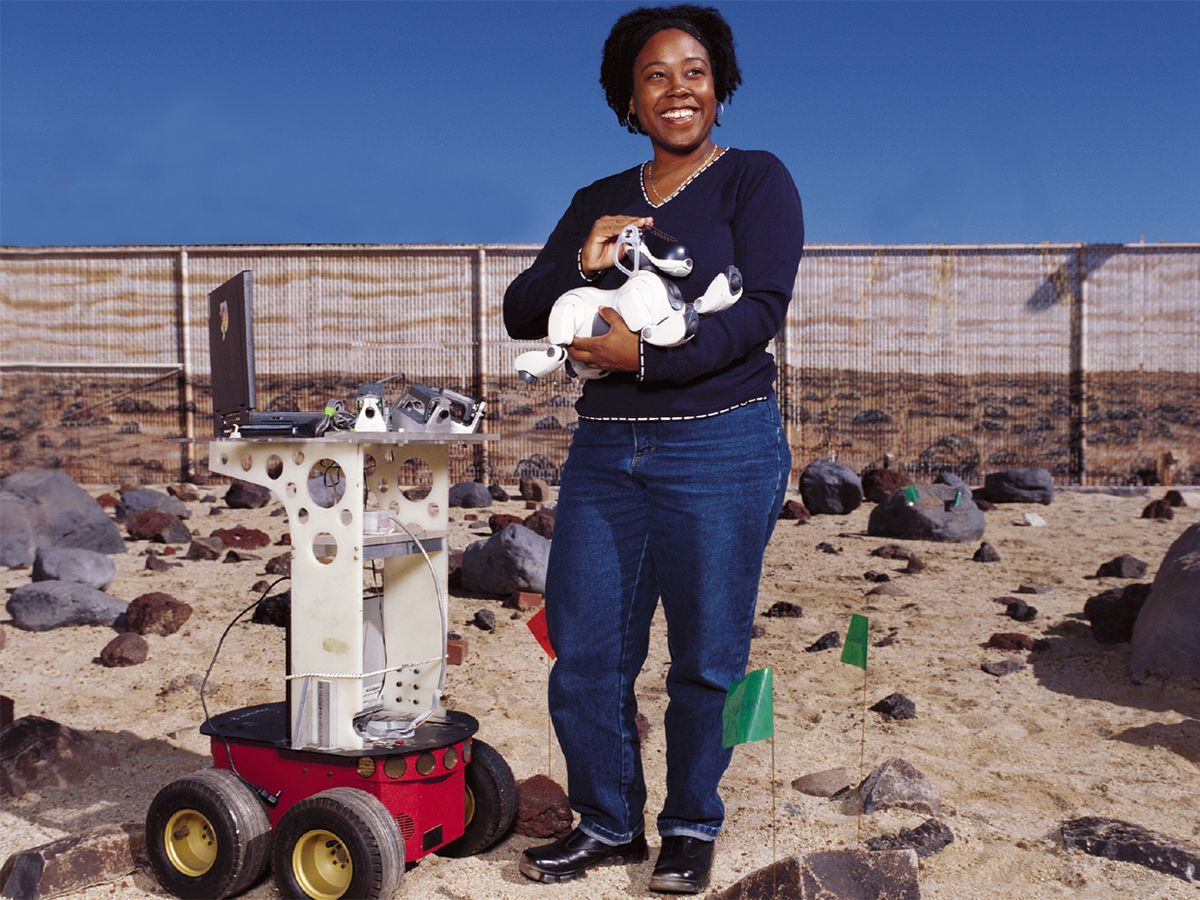Ayanna Howard: Robot Wrangler
The next generation of Mars rovers will owe their brains to the fan of “The Bionic Woman” TV show

Mars on Earth: Ayanna Howard cradles a Sony AIBO robot used to test new software approaches, in JPL’s Mars Yard. Here, prototype Mars rover designs are put through their paces in a simulated Martian landscape.
NASA’s twin Mars rovers, Spirit and Opportunity, have already rewritten the book on the Red Planet’s history, their amazing discoveries transmitted to an audience of millions. But is not content to let NASA rest on its laurels. She’s designing future generations of robotic explorers to bring back even more science for the buck. Her goal: a robot that can be dropped off on a planet and wander around on its own, eliminating the kind of intense supervision from Earth that Spirit and Opportunity require—their every move must be meticulously choreographed in advance and on a daily basis.
“I want to plop a rover on Mars and have it call back when it finds interesting science,” Howard says. “Like a geologist, it should wander around until it sees something that might be interesting. Then it should be able to investigate further and decide if it’s really interesting or just another rock.”
Howard works as a senior robotics engineer at NASA’s Jet Propulsion Laboratory in Pasadena, Calif. The laboratory has dominated the robotic exploration of the solar system since the earliest days of the Space Age.
Space exploration, however, is only a test bed for Howard’s ultimate technical objective: making robots better at helping people. “It’s bigger than space exploration—it’s robots assisting people,” she says. “But space exploration is definitely one of the prime ways that robots assist people.”
The 1970s TV show The Bionic Woman sparked Howard’s interest in human-robot interaction and inspired her to become an engineer. The TV series depicted a severely injured woman who was given superhuman powers, courtesy of bionics: artificial replacements for human parts. “But around the 10th grade, I took biology—and I hated it!” Howard says.
She was stuck, because she knew she’d need medical training if she were going to attach limbs to people. Then someone suggested she check out robots. “I could still build limbs and figure out how to make them move, and as long as I didn’t work on people, I didn’t have to go to med school,” Howard remembers thinking.
So she studied computer engineering—at Brown University in Providence, R.I., because her parents insisted she leave her native California for her undergraduate education. “They felt California was too laid back!” she says, laughing. She returned to the West Coast for her school-break vacations, and she was accepted to JPL’s summer program for students.
“When I first got here, I was designing a database. I didn’t even really know that JPL had robotics until I started talking to people. Then I realized all these spacecraft, like the Voyager probes, were robots,” she recalls. Howard kept working at the laboratory during summers, nurturing her growing interest in artificial intelligence. After graduating from Brown, she earned a master’s degree and then a doctorate in electrical engineering from the University of Southern California, in Los Angeles, while working at JPL.
Ayanna Howard
IEEE senior member
Age: 33
What she does: Develops autonomous robots
For whom: NASA’s Jet Propulsion Laboratory
Where she does it: Pasadena, Calif.
Fun factors: Her robots could end up exploring Mars and beyond
What Howard likes best about her job is integrating diverse hardware and software elements into a working robot. “Problem shooting with a device that you have to touch and interact with is the hardest part of developing a robot, but it’s the most fulfilling,” she says.
Howard is working toward an MBA as she looks beyond her days as a nuts-and-bolts engineer. “I have a bigger vision in terms of what I want to do when I’m 50,” she says. “It’s being an administrator at NASA headquarters or being president of a major university.” But even in her current job, she says she feels the MBA training is giving her an edge. “They teach you soft skills which, as engineers, we don’t really master. Things as simple as dealing with people,” she explains.
“It’s about being strategic in what you want to do. Who do I need to talk to so that my technology will be adopted for a mission? It may not be the program manager that’s directing that mission. You may need to go to the chief technologist. Everything is a web. You’ve got to understand the web.”
Howard also mentors disadvantaged girls and frequently addresses elementary and high school students, often in poor neighborhoods. Although a lack of computers and other resources can be a big problem, she finds that simply showing up and explaining that you can make a good living as an engineer can widen a child’s horizons. “They haven’t talked to somebody who’s a professional, except for teachers,” Howard says. “They look at TV, and it’s all acting and sports, so that’s what they want to be. But when you meet children, it’s surprisingly easy to get them excited about engineering.”
Howard may be shortchanging herself as a motivator—her own excitement is palpable as she talks about engineering. She once decided to try some non-engineering-related hobbies, but found that they “felt like work,” she says with a chuckle.
“My hobby is my job,” she adds. And if the first mission to use technology she invented departs for Mars early next decade, as planned, Howard will be among the select few who count exploring planets as one of their hobbies.
To Probe Further
For more information on Ayanna Howard’s efforts to build autonomous Mars rovers, see https://telerobotics.jpl.nasa.gov/people/howard/SafeNav_files/v3_document.htm. The Jet Propulsion Laboratory has a career Web site at https://careerlaunch.jpl.nasa.gov/that includes information for student summer programs as well as job listings.